The beautiful delicate anemone is considered an indispensable attribute of every garden, a cute, unpretentious flower. But some gardeners just can’t make friends with it - either it gets wet or freezes. What's the secret?
Photo of anemones in the garden
| Content:
|
But the fact is that a rare plant has such extensive species diversity and such differences in the growing conditions of each species. Hence all the failures and disappointments of gardeners. However, anemone is worth understanding the secrets of its cultivation.
Anemone flowers - description and characteristics
In Russia, planting anemones in open ground has been practiced for a long time. Here they call her ANEMENEMY. The flower belongs to the ranunculaceae family and is a perennial. A large number of anemone representatives are divided into species according to the type of structure of the root system. There are tuberous and rhizome varieties.
Knowing the type of anemone is very important to ensure proper care, because this is a long-lived flower. Some wild varieties live up to 50 years in natural conditions, and cultivated varieties have several methods of reproduction, which provides them with almost the same longevity. So, having made friends with this plant once, you can keep it on your site for quite a long time.
Anemone is universal:
- it is suitable for both landscape design and cutting,
- flower colors are very diverse,
- flowering - from early spring to late autumn.
It would be possible to create a magnificent, constantly blooming flower bed from anemones alone, if their growing conditions coincided.
Planting anemones in open ground
Depending on the type of anemone, certain conditions are provided for growing in open ground.
Shade-loving. These include radde, shadow, Altai, buttercup, Amur, oak, flexible, Udin, smooth, etc.
These anemones are rhizomatous and bloom in early spring. They prefer dense shade, moderate temperature, high humidity, i.e. It is best to place them under the canopy of trees.
They require loose, fertile soils with good drainage, slightly acidic or neutral.
Note! Flexible, Amur and Altai anemones can grow in partial shade.
Shade-tolerant. These are hybrid, Japanese, Hubei, forked, forest, Canadian, etc. These are also rhizomatous anemones.
An interesting feature: forked, forest, and Canadian anemones form root suckers and bloom in May–June, while hybrid, Japanese, and Hubei anemones do not have root suckers and bloom in the fall.
Shade-tolerant anemones require partial shade, a clearing in regions with a cool climate, and constant but moderate humidity. The diffused shade of sparse trees and an area illuminated by the evening sun are the best planting sites for them.
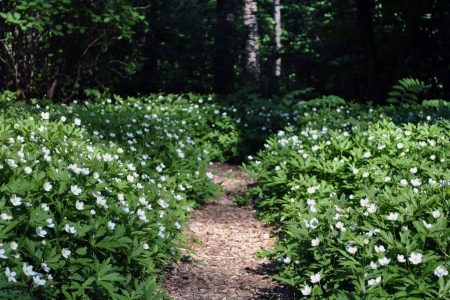
Canadian anemone
Soils prefer light, peaty or sandy, with good drainage, slightly acidic or neutral.
Photophilous. This community is represented by two types of anemones - tuberous and rhizomatous.
The tuberous plants are crown, tender, Apennine, Caucasian, etc. Of these, the Apennine one will bloom first, the rest join it in April - May.
These anemones require a sunny location. They have such an important quality as drought resistance. They need loose, fertile, alkaline soils.
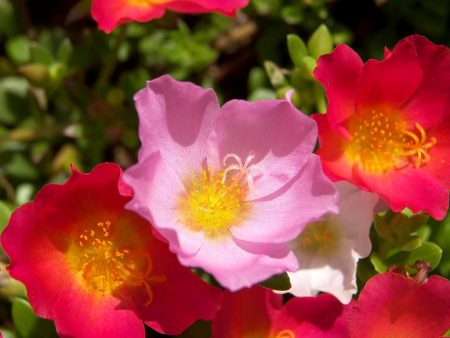
In the photo the Apennine anemone
Light-loving rhizomatous anemones are daffodil and long-haired.Flowering time is May – June.
These anemones also literally need a place in the sun. They, of course, are inferior to tuberous plants in drought resistance, but are still able to temporarily tolerate a lack of moisture. Soils suitable are loose, fertile, slightly acidic or neutral.
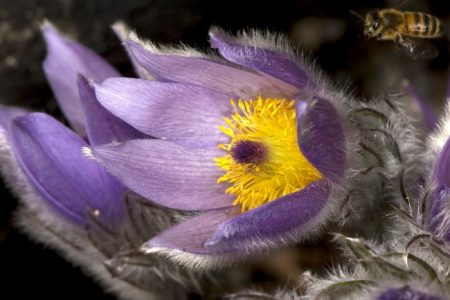
Anemone long-haired
Anemones can be planted in 4 ways
When planting anemones in open ground, you should prepare a fairly spacious area, as the flower grows well. Anemone can be planted in several ways:
- seeds in the ground in spring or autumn,
- mature rhizomes in the middle of the season,
- root shoots in the spring,
- tubers in spring.
1 way. Seeds in the ground
Any type of anemone can be planted this way. To do this, it is necessary to fence the area with a flexible border or boards, and prepare the soil of the desired structure and acidity. It is important to remember that anemone seeds have difficulty germinating, so before spring sowing it is necessary to stratify them.
To do this, the seed is mixed with soil or sand, moistened and stored in the refrigerator at a temperature of +6 degrees for three weeks. At this time, the seed shell softens under the influence of cold and moisture, the metabolic processes of the embryo slow down, and its vitality is preserved.
When favorable conditions occur, the embryo awakens, easily breaks the shell and germinates. The best time for spring sowing is the onset of consistently warm weather and an air temperature of at least +16 degrees.
Autumn sowing into open ground with fresh material will give better seedlings, since the anemone seeds will undergo stratification under natural conditions. The area for crops and the soil are prepared in the manner described above.
Planting in open ground occurs at the end of August - September.The seeds are distributed over the area, lightly sprinkled with soil, covered with non-woven material and left until spring. With the onset of warm weather, the covering material is removed, and after a while a large number of young plants will appear.
Method 2. Planting with mature rhizomes in the middle of the season
This method is used because many types of anemone lose their leaves after flowering and then they will be difficult to find. Usually this is how a very overgrown bush is thinned out. Mature rhizomes take root quite easily in a new place.
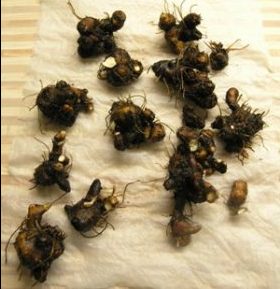 Rhizomes prepared for planting |
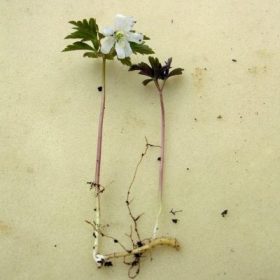 Root shoot with two buds |
3 way. Root shoots in spring
This planting method is suitable for those types of anemones that produce forcing from the root. A small section of the root with buds and sprouts is carefully cut off from the mother bush and planted in the prepared soil in a permanent place.
4 way. Planting tubers in spring
Most often, newly purchased or stored tubers from last autumn are used. They must be carefully inspected before planting. Sometimes there are dry or rotten spots on the tuber that need to be carefully removed with a sharp knife. The cut area must be treated with wood ash and dried. It is advisable to keep healthy tubers for half an hour in a pale pink manganese solution.
Tubers wake up slowly, so they need to be taken out of storage early and awakened. To do this, you can put them in water for several days or wrap them in a napkin soaked in Epine solution, then in a plastic bag for 6 hours. This will be a good start for the plant.
After some time, bumps will appear on the tubers. These are buds, not roots. From here a sprout will appear and it is with this surface facing up that the tuber needs to be planted.Another guideline is that the sharp part of the tuber is located down, and the flat part is located up. If the tuber has already woken up, and it is too early to plant it in the ground, then you can temporarily plant it in any container with suitable soil, and then move it to a permanent place. But such an anemone will bloom much earlier.
Remember that for tuberous anemone Need alkaline soil! To do this, lime or ash is added to the soil before planting. During the season, the soil around the plant is sprinkled with ash and loosened a couple more times.
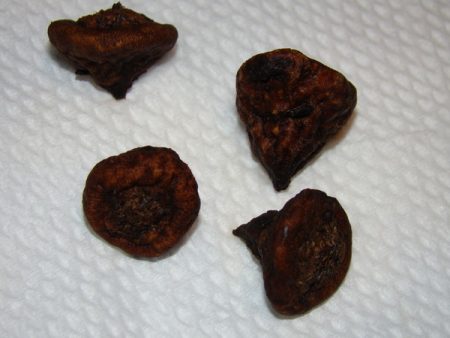
Landing with the pointed end down and the flat end up
Anemone transplant
Anemone grows quickly and covers large areas, so every 3 to 4 years gardeners are faced with the problem of transplanting it to a new location. Most anemone species tolerate this procedure very well, even during flowering. And yet each type has its own deadlines:
- Rhizomatous anemones that bloom in early spring need to be replanted before they drop their leaves; later they simply cannot be found.
- Root-sprouting varieties are best replanted in the spring, when young shoots appear. These anemones tolerate autumn replanting less well, but if necessary, this can be done in early September.
- Tuberous anemones are also replanted in the spring, as it becomes clear how the tubers survived the winter and in what condition they are.
- Only the hybrid anemone reacts painfully to division and moving to a new place. If you really need it, it is better to do it in the spring. As a result of autumn replanting, most of the plants die.
When replanting, it is absolutely not necessary to dig up the entire clump. It is necessary to isolate the rhizome with buds or sprouts, carefully separate them and transfer them to the prepared hole.But if there is a need to completely clear the area of anemones and transplant them to a new place, then dig up the entire bush and divide it into parts. Each new plant should consist of a rhizome with 2-3 well-developed buds.
The place for a new planting is filled with soil that is suitable specifically for this species. The depth of the hole for rhizomatous anemones is 10 cm, for tuberous anemones – 2-3 times the height of the tuber. Fresh plantings need to be watered and mulched with humus or peat.
If anemones with buds are tolerated, they need to be fed with mineral fertilizers for flowering plants. Flowering and seed formation require a lot of effort, especially if this period is combined with transplantation. Moved plants without buds will bloom only next spring.
Caring for anemones in the open ground
Watering
Each specific location has its own requirements for this care procedure. Where it rains often, anemone can do without watering at all. And in arid areas, sometimes you have to moisten the plantings every day. You also need to care for anemones in the open ground in accordance with the type of plant.
- Shade-loving anemones prefer not to swamp, of course, but to constantly have moisture.
- Shade-tolerant plants require moderate watering.
- Light-loving plants can even withstand drought, but you shouldn’t challenge the plants. It is better to provide the anemones with such care that they respond with lush flowering.
- All species benefit from watering in the spring when plants awaken, during the period of intensive growth and the appearance of buds, during transplantation, during hot weather and in the fall as a moisture-recharging measure.
Feeding
It is advisable to prepare fertile soil for planting anemone.However, flowers do not tolerate fresh manure well, so you only need to add rotted or compost. Young plants will receive their first feeding from the nutrient soil.
- For active growth of green mass of both young and adult plantings mineral fertilizers are neededcontaining nitrogen. It is better to apply them in early spring.
- When bud formation and flowering begin, anemones need more phosphorus, potassium and manganese. They are contained in complex mineral fertilizers. By applying this fertilizer, it will be possible to extend the flowering period.
- In the fall, you also need to feed the anemones so that they can better survive the winter. In this case, mineral fertilizers with a reduced nitrogen content are used and mulching is done with peat or humus.
Loosening
When growing anemones in open ground, you cannot do without loosening, because all types of these flowers love light, oxygen-saturated soils. Therefore, after each watering and mulching, loosening should be done.
In addition, when caring for tuberous anemones, loosening is carried out twice a season with the addition of wood ash to maintain soil acidity at a low level.
Anemone, like many buttercups, does not tolerate sodding. In this case, loosening helps get rid of weeds and keep the plantings clean.
Anemone propagation
These flowers have several methods of reproduction: most - by seeds and vegetatively, some - by seeds and tubers. This explains the long-term presence of anemones in landscaping areas.
Seeds The propagation process is difficult, since stratification of seeds in natural or created conditions is required. Nevertheless, anemone plantings often expand due to self-seeding.The planned methods of propagation by sowing in open ground are described above.
Vegetative reproduction is easier.
- Some anemones (forked, Canadian, forest) form offspring, which can later be cut off from the mother bush and replanted. The best time for this procedure is early spring.
- Others (Altai, Amur, buttercup, shadow, etc.) during the season form roots so that separate fragments with its own rhizome and growth buds. When dug up, a bush of such anemones can be divided, without cutting, into fragments, planted, and flowering plants obtained the very next year.
- In a way natural During the growing season, the same oak forest, Amur, and Altai anemones reproduce. This happens if the resulting fragments are not dug out. Gradually, the mother bush will spread, form new separate rhizomes, then weaken and die. And young shoots from rhizomes grow around it. The entire cycle lasts from 2 to 5 years.
- Division The bush is well tolerated by daffodil and long-haired anemones. In early spring, at the beginning of the growing season, or in autumn, before the onset of the dormant period, the plant is dug up, a section of rhizome is separated from the mother bush and divided so that each particle has 2–3 buds. The queen anemone can be returned to its place, and the divisions can be treated with root or epin and planted in the ground. This event is more successful in the spring than in the fall.
Tubers or parts of tubers, crown anemones, Apennine anemones, tender anemones, and Caucasian anemones reproduce. It should be noted that these species are not considered frost-resistant. In most regions, their tubers are dug up in late July - early August and stored until spring.
In early spring, after the tubers awaken (see the description of the awakening procedure above), you can begin to divide them. Each piece of tuber should have at least one, and preferably several, buds. Then the cuttings need to be dried, sprinkled with wood ash and planted in a permanent place. Further care in open ground is the same as for other young plantings.
This procedure can be performed in late autumn, but there is a possibility of the tubers freezing or getting wet.
Using anemone in garden design
When drawing up landscape compositions, it is necessary to take into account the type of anemone in order to ensure proper care in the open ground, as well as the flowering period, the height of the peduncles and the color scheme of the flowers.
For example, Altai, shady, and oak anemones tolerate shade well, and they also bloom in early spring. In the conditions of an awakening garden, in the tree trunks of shrubs and trees, they will look great.
Apennine, crown and tender anemone love the sun, but bloom at different times: Apennine - in early spring, and the other two - in May - June. If you plant them side by side, you will get an elegant, long-blooming flowerbed. And if you add tulips there, it will be impossible to take your eyes off! By the way, such a mixborder does not require watering.
Low-growing anemones 20–25 cm high are used to frame paths between trees. Buttercup, oak and blue anemone are best suited for this, as they grow in the shade and cool.
The tender anemone is also short, only 20 cm, but it is demanding of the sun and tolerates a lack of moisture, so it can be successfully used in rock gardens. Even after flowering has ended, its graceful leaves will serve as a decoration for the alpine hill.
Forest anemone, unpretentious and hardy, produces flower stalks up to 35 cm in height. Its snow-white flowers are used in bouquets, as well as crown anemones.
Crown anemone is interesting because it has large double and semi-double flowers of a wide variety of shades: white, crimson, purple and even white with a crimson stripe (Bicolor).
From autumn-blooming The Japanese anemone is very good. It has a high peduncle, up to 90 cm, and large red flowers (variety Siyanie). Another variety, equally tall, has smaller pink inflorescences (September Charm). Both varieties are unusually decorative; they are often planted in mixborders and used for cutting.
You can endlessly fantasize and experiment with anemone, which is why this flower is so loved by gardeners. Of course, it’s such a beauty, and even in the open ground it requires very little care!
Forcing anemones
You can also make anemones bloom even in February or March. For such a pleasant surprise, large, from 5 to 7 cm in circumference, crown anemone tubers are suitable.
- In October - November they are soaked in water or epin solution to awaken them.
- Then they are planted in boxes with loose soil quite often, about 60 pieces. per 1 sq. m. Remember that you need to plant anemone tubers with the sharp end down!
- The flat surface of the tuber is covered with 3–4 cm of sand on top, watered and the box is left in a dark, cold (+5 degrees) room.
- In December or January, the box is transferred to the light, providing a spring temperature of about +14 degrees.
- At the same time, moderate watering begins, and when buds form, fertilize with mineral fertilizers for flowering plants.
- This way you can grow an original gift with your own hands for February 23rd or March 8th.
Diseases and pests
To the delight of gardeners, anemones rarely get sick or are affected by pests. More often, problems arise in areas with a humid climate.
- Dampness may cause gray rot, from which medications containing copper will help: HOM, Bordeaux mixture, AbigaPik, etc.
- Slugs and snails They also prefer a humid climate. To combat these harmful mollusks, preparations with metaldehyde are intended - GROM and META.
- If found aphid, then it is worth spraying the plants with insecticides Biotlin, Doctor, Tanrek, etc. in accordance with the instructions.
- When signs appear nematodes – yellow-brown, gradually darkening spots on the leaves and stems; the diseased plant must be removed and the soil treated with bleach.
Signs of nematode damage
Preparing for winter
Many rhizomatous Anemone species are quite hardy, but they also require a number of preparatory measures in order for them to survive wintering well in the open ground.
- One of the main activities is mulching. To do this, make a pillow 15–20 cm thick from peat or compost. You can make the same pillow from dry leaves or pine branches.
- Before mulching, you should not trim the leaves and stems of plants in areas where there are severe winters. And, on the contrary, in regions with a warm climate, the green mass must be removed to avoid the formation of rot.
- Anemones transplanted in summer and autumn must be covered with covering material after mulching.
Some tuberous anemones overwinter in open ground, for example, tender anemone. But she may face another danger - getting wet. Therefore, it is better not to take risks, but to dig up all the tubers and provide them with good conditions for wintering.
- The tubers are dug up after the leaves die, carefully cleaned of their remains and dried.
- To prevent the tubers from drying out, they are placed in sand or peat and stored all winter at + 5 degrees.
- In the spring, the tubers are removed, inspected, divided into parts if necessary, and measures are taken to awaken them.
The best varieties
Anemone is loved not only by gardeners, but also by breeders. Every year more and more new varieties appear. So in 2018, several new Japanese tuberous anemones are offered for cutting:
Curly swan – a tall variety (70–80 cm) with large white flowers, blooming from June to October.
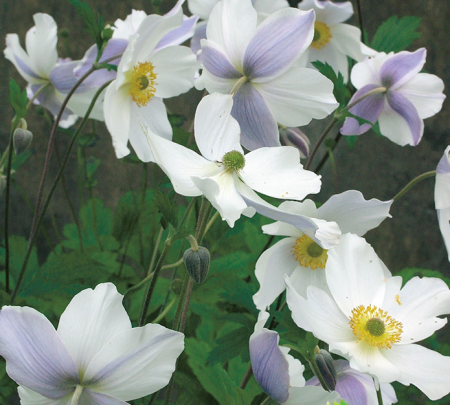
Pictured is the anemone Curly Swan
dreamy swan - similar to the previous one, but with soft pink buds that turn into snow-white double flowers. This variety may well keep the Curly Swan company, because... blooms from August to September.
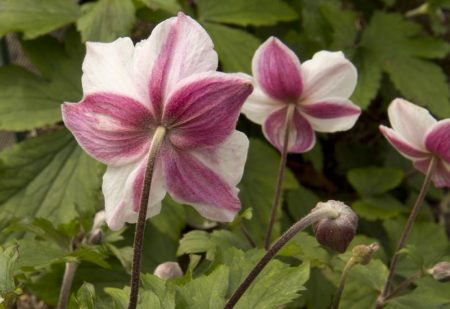
This photo shows the anemone Dreamy Swan
snow whirlwind - even taller - up to 120 cm, also has large double white flowers, flowering in August - September.
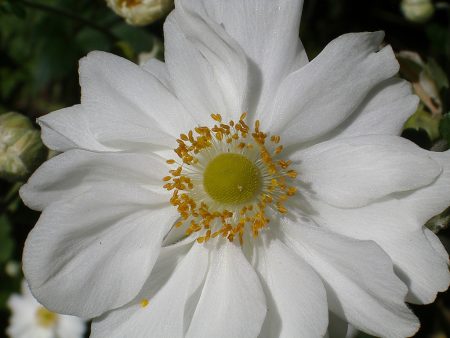
Anemone Snow Whirl
And that's not all that's new!
Of the famous varieties - everyone's favorite Hubei anemone Crispa. It is unique for its unusual foliage. At first it can be mistaken for curly parsley, but the edges of the corrugated leaves are surrounded by a cherry border. In August, strong flower stalks up to 60 cm high shoot out from this stunningly beautiful clump, and large pink flowers open. This beauty pleases the eye for more than a month.
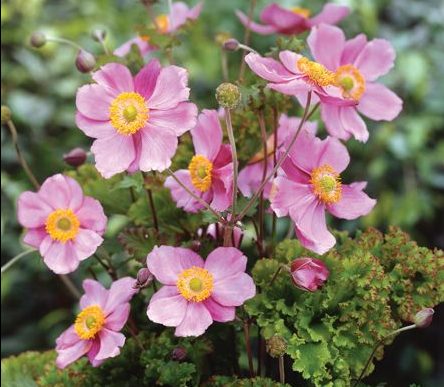
Anemone Hubei Crispa
Wood anemone Blanda Blue Shades differs in winter hardiness. It is short, 20–25 cm, but looks bright and impressive due to its large blue-violet flowers with yellow stamens.
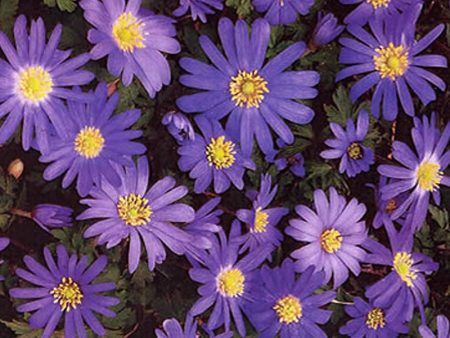
Anemone Blue Shades
Anemones Tenderness usually sold in a mixture and come in white, light blue and deep blue.These babies (height 15 cm) bloom already in April and decorate alpine hills with a bright spot or serve as a delicate border of garden paths.

Mixture of anemones Tenderness
You can describe the beauty and charm of these wonderful flowers endlessly, but it is better to choose your own anemone or several that will suit your yard and will enjoy living with you. And, as you can see, caring for anemone in open ground is not difficult.
Continuation of the topic:
- Growing seedlings of perennial flowers
- Growing Echinacea
- How to grow delphinium from seeds
- Growing Brugmansia from seeds
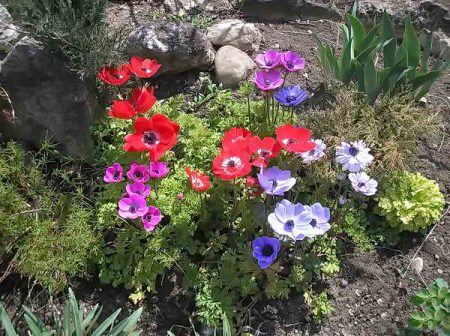
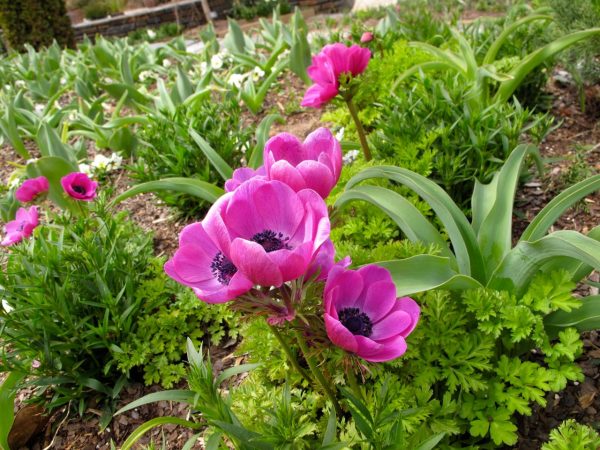

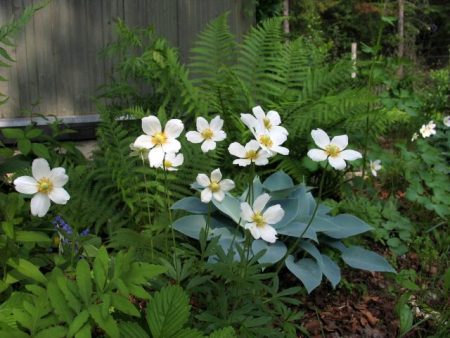
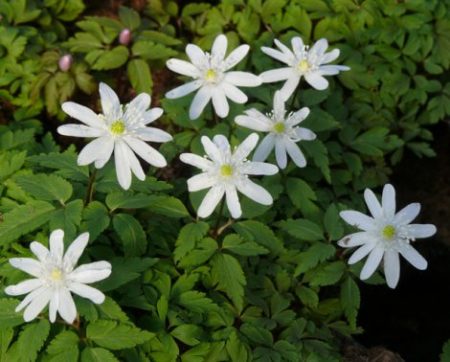
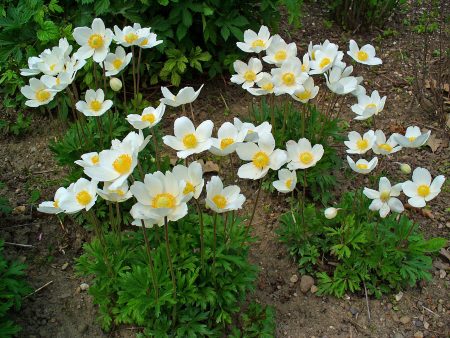
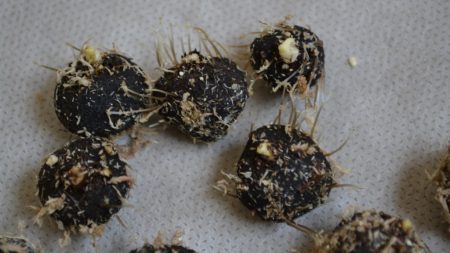
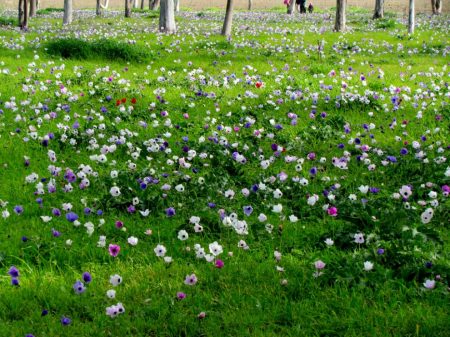
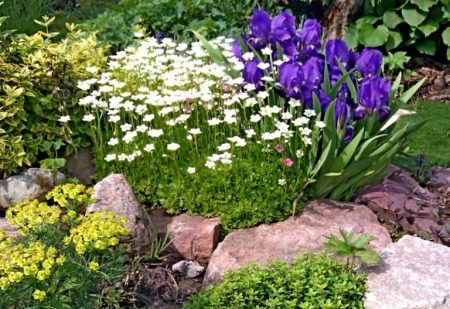
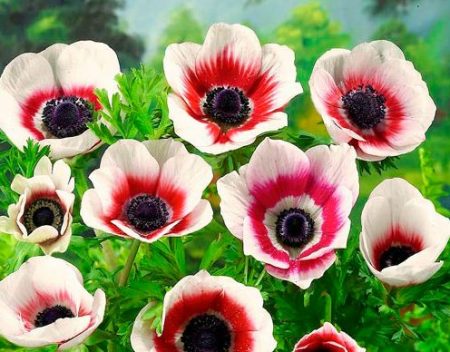
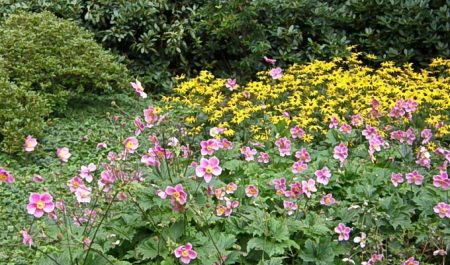
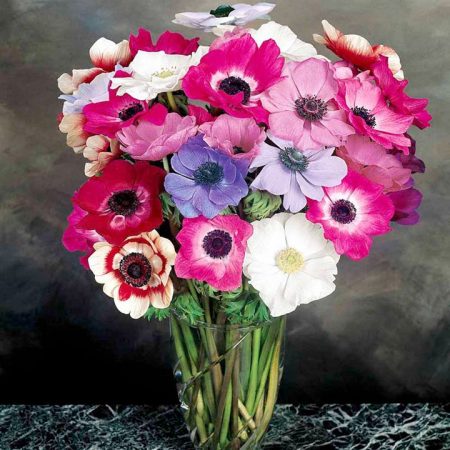


 (1 ratings, average: 4,00 out of 5)
(1 ratings, average: 4,00 out of 5) CUCUMBERS NEVER GET SICK, I'VE BEEN USING ONLY THIS FOR 40 YEARS! I SHARE A SECRET WITH YOU, CUCUMBERS ARE LIKE THE PICTURE!
CUCUMBERS NEVER GET SICK, I'VE BEEN USING ONLY THIS FOR 40 YEARS! I SHARE A SECRET WITH YOU, CUCUMBERS ARE LIKE THE PICTURE! You can dig a bucket of potatoes from each bush. Do you think these are fairy tales? Watch the video
You can dig a bucket of potatoes from each bush. Do you think these are fairy tales? Watch the video
 How our fellow gardeners work in Korea. There is a lot to learn and just fun to watch.
How our fellow gardeners work in Korea. There is a lot to learn and just fun to watch. Eye trainer. The author claims that with daily viewing, vision is restored. They don't charge money for views.
Eye trainer. The author claims that with daily viewing, vision is restored. They don't charge money for views. A 3-ingredient cake recipe in 30 minutes is better than Napoleon. Simple and very tasty.
A 3-ingredient cake recipe in 30 minutes is better than Napoleon. Simple and very tasty. Therapeutic exercises for cervical osteochondrosis. A complete set of exercises.
Therapeutic exercises for cervical osteochondrosis. A complete set of exercises. Which indoor plants match your zodiac sign?
Which indoor plants match your zodiac sign? What about them? Excursion to German dachas.
What about them? Excursion to German dachas.